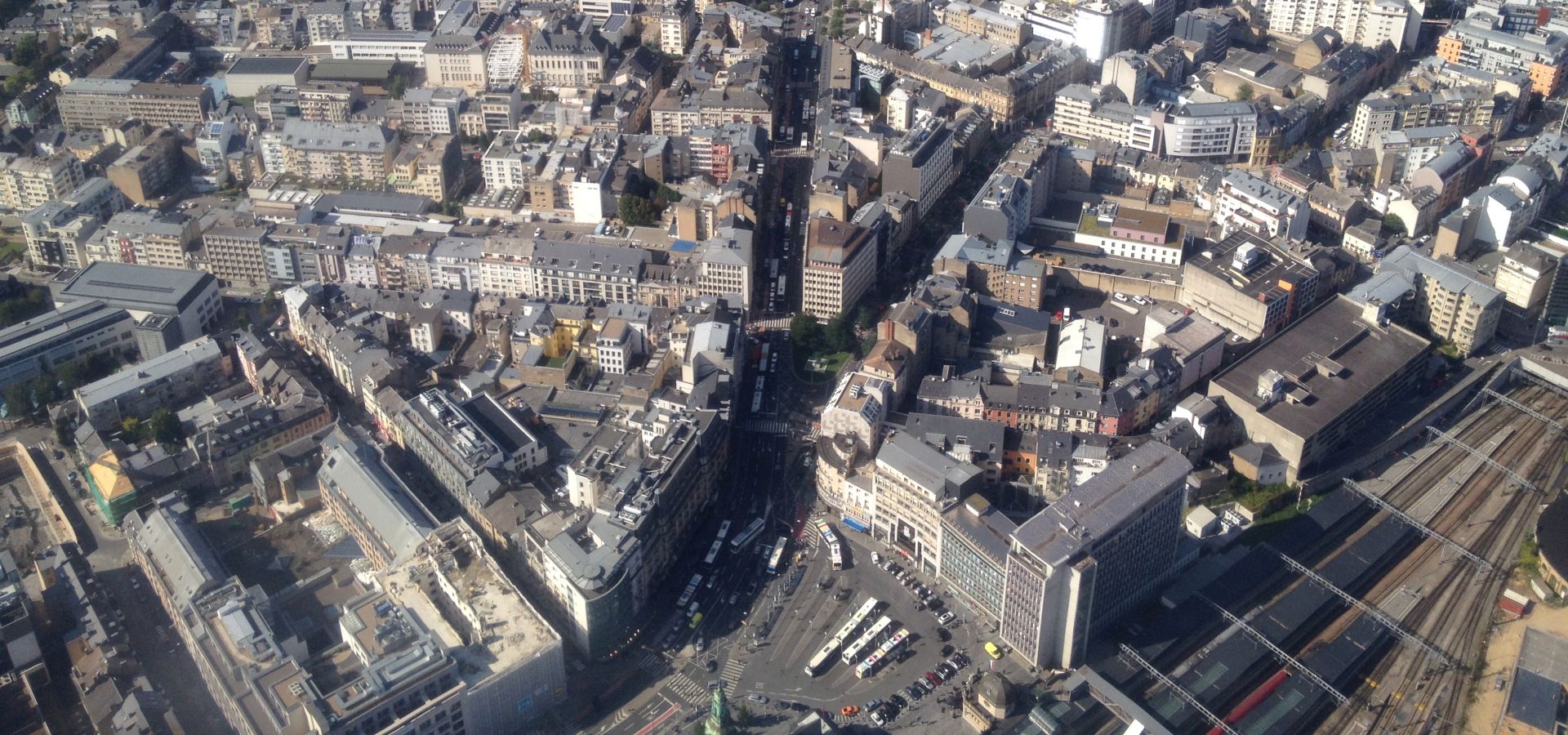Luxembourg has been aiming to reach its 2020 energy objectives, but there are some difficulties in reducing emissions which come from being a small, transit country. Nonetheless, the government is implementing various strategies to improve efficiency and transportation. Nora Weis has the details.

Luxembourg City from above (Photo by Bdx, edited, CC BY-SA 4.0)
Renewables in Luxembourg? Always waiting for sunshine!
Luxembourg is a small country in the heart of Europe located between Belgium, France and Germany. Due to its small size, it is a transit country for the transportation of goods and people by road and rail. The country imports electricity mainly from Germany, but also from the neighboring countries Belgium and France.
Luxembourg also generates domestic electricity in 133 co-generation plants and 5,979 small photovoltaic plants, as well as 54 wind, 33 hydro-electric, 34 biogas, 7 waste water treatment and 2 thermal power plants. Some well-known examples are the Twinerg combined-cycle gas turbine in Vianden, the hydroelectric power plant in Esch-sur-Sûre and the barrages on the river Mosel. The Grand-Duchy covers 20.5% of its consumption by national production, 6.7% of which comes from renewable energies. The national institute for regulation ILR provides statistics and detailed information regarding the status and evolution of the national energy sector.
Objectives by 2020
Luxembourg’s national energy efficiency target by 2020 aims to save 2,698 GWh, in comparison to the predicted 2020 energy consumption of 51,486 GWh. The national production of renewable energies amounts to 430 GWh, and biogas and photovoltaic receive about 80% of the allocated public funds for renewables (66.4 mio € in 2015).
About a quarter of the savings are expected to be achieved through the promotion of energy efficiency in buildings. To that end, a public information and advisory body, myenergy agency, has been created to advise and raise awareness. Furthermore, Luxembourg introduced in its third National Energy Efficiency Plan in 2014, a scheme of energy-saving obligations applicable to all suppliers operating in Luxembourg. Energy audits will be mandatory for about 150 large companies established in Luxembourg.
The Climate Pact was introduced in the same year on a municipal level in order to implement an energy management system for public infrastructure. Despite a wide range of financial support measures, high property prices hinder investments for energy-efficient renovations of buildings. A public regulation of the housing market is necessary, as authorities opt for solutions such as tax write-offs on investments or the creation of a reserve for energy renovations. Luxembourg also grants financial support for low-energy and passive houses and buildings.
How to “un-fuel” Luxembourg
In the transport sector, the government should raise taxes on fuel and vehicles in order to encourage more sustainable ways of transport. The anticipated energy savings in 2020 are expected to amount 66 GWh regarding fuel and 86 GWH for vehicles, which does not seem to represent a real challenge.
Nearly three-quarters of energy consumption from road transport is from transit traffic, due to the country’s geographical situation as well as to its lower fuel prices. Luxembourg attracts visitors from abroad and thus favours cross-border transit with low taxes on fuel, alcohol and tobacco. The economic value is significant for the country (10% of the State budget) but the transport sector is responsible for more than 50% of energy-related CO2 emissions.
The government has created a strategy for sustainable mobility targeted at daily transport and short trips. The expansion of park & rides and the construction of a tram system in the capital city, as well as additional rail transport for civil and industrial uses, aim to encourage citizens and the industry to use public transport. Through the promotion of electromobility, the government aims to replace 10% of Luxembourg’s cars by electric vehicles by 2020.
Luxembourg and the third industrial revolution
The evolution of information technology, climate change, pollution and the transition to a circular economy lead us today to another era, the third industrial revolution. Jeremy Rifkin‘s concept enables countries to become more self-sufficient, based on information technology, green energy and electric transport.
Given the fact that Luxembourg imports most of its energy, the country could become more self-sufficient through the promotion and development of smaller local renewable energy structures. The development of circular green data centres with very low carbon emissions, for example, is attractive to international companies and institutions.
Economic growth over sustainability
Luxembourg clearly makes efforts towards renewable energy sources and encourages small local plants. The country nevertheless depends primarily on imports from operators in neighboring countries, especially in Germany. Even though its small size comes with advantages, the Grand-Duchy may not be of interest for investments and development from renewable energy companies, and may not have enough capacities to generate the domestic energy required by consumers.
The country continues to invest in research and development especially of small national plants such as the wind power project oekostroum. These investments are at the same time expected to be beneficial to its economy.
Regarding CO2 emissions in the transport sector, authorities are reluctant to raise taxes on fuel in order not to affect the important income from cross-border transport. Furthermore, Luxemburg’s energy market is not competitive and regional providers from neighboring countries are not (yet) operating in Luxembourg due to administrative, geographical and linguistic constraints.
In the end, investments in renewable energies are driven by economic interests rather than by a sustainability objective. An integrated climate and energy strategy with a clear focus on renewables and the reduction of CO2 emissions for 2030 and beyond are therefore most desired.
Nora Weis is a freelance journalist from Luxembourg.
Luxembourg is hilly. It could build a pumped-storage facility and sell the service to its neighbours. Unfortunately this useful contribution to sustainability would not show up in the EU targets.